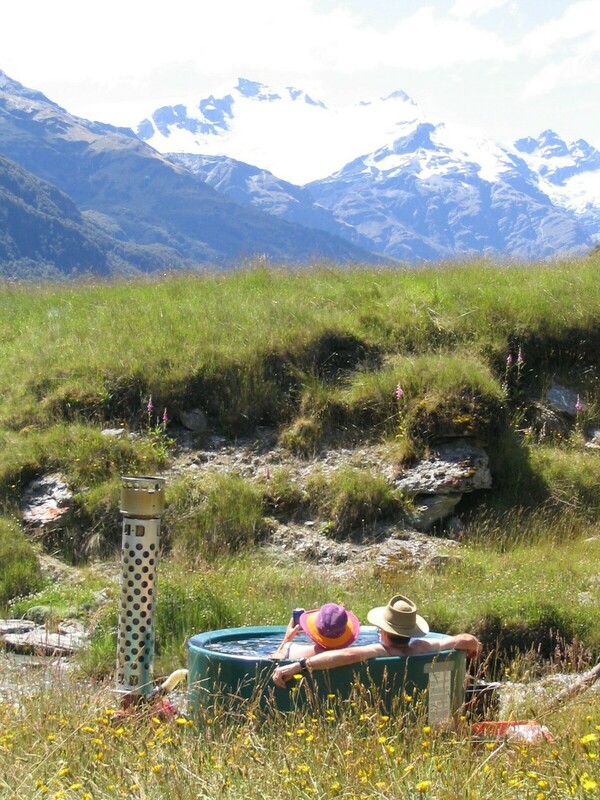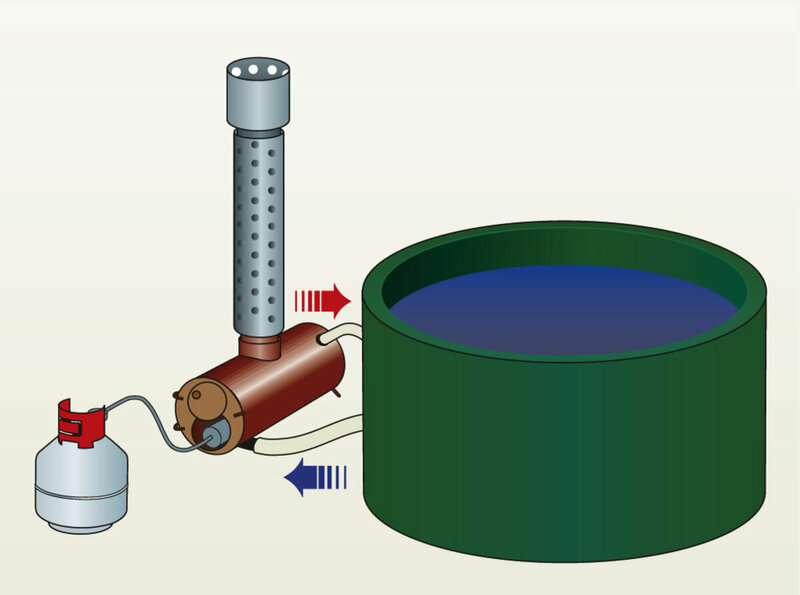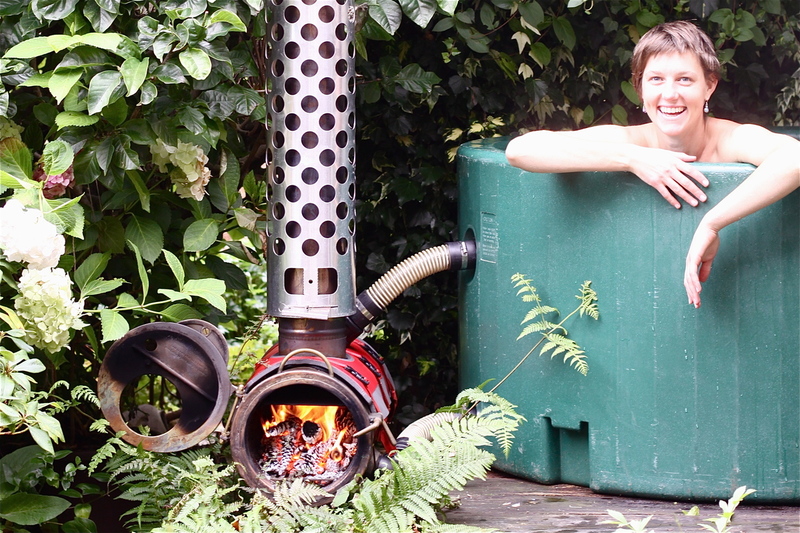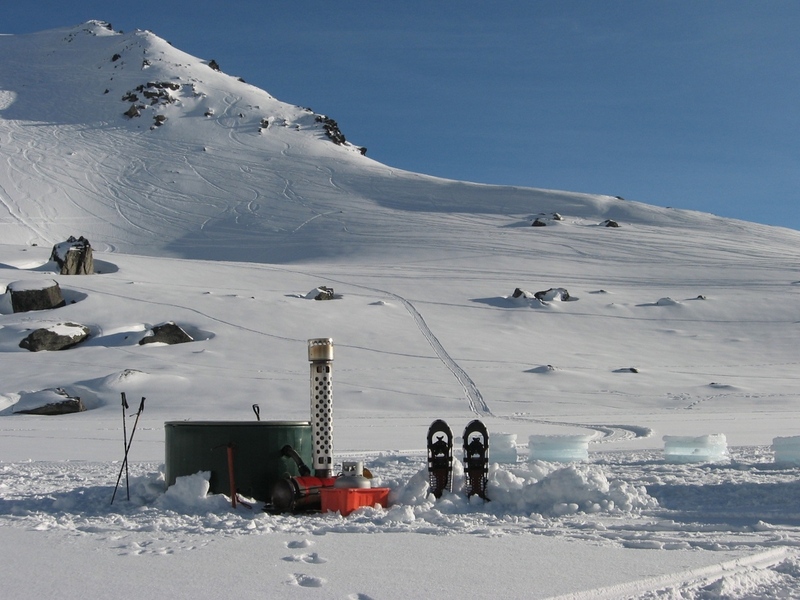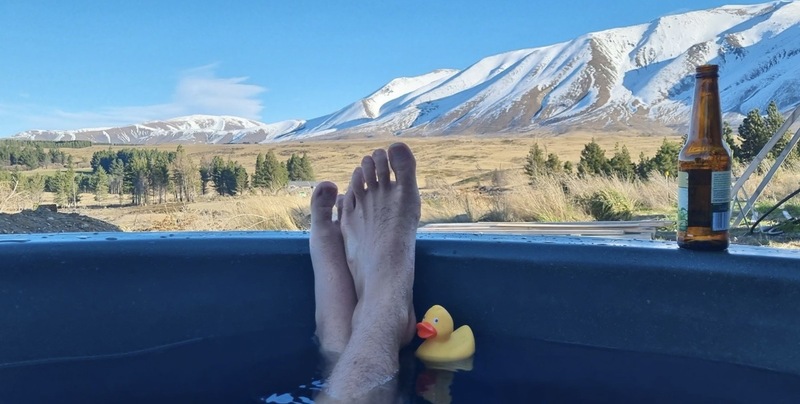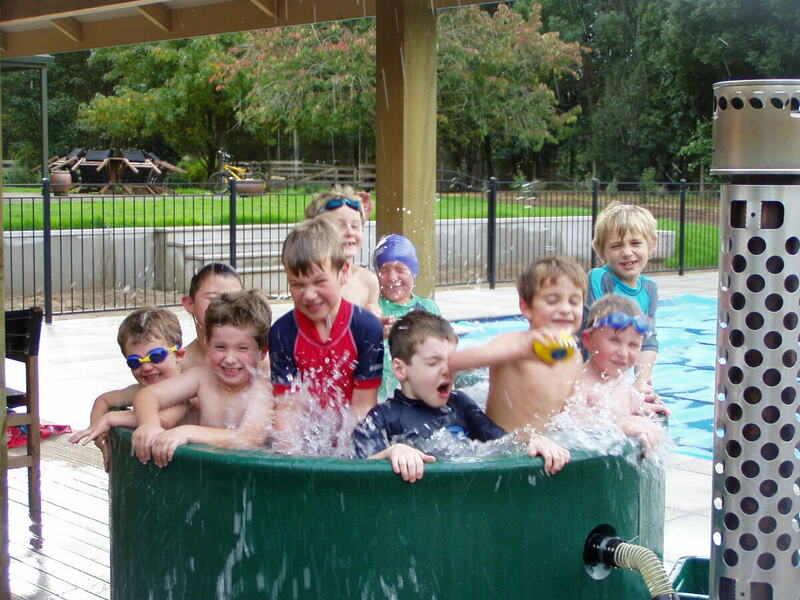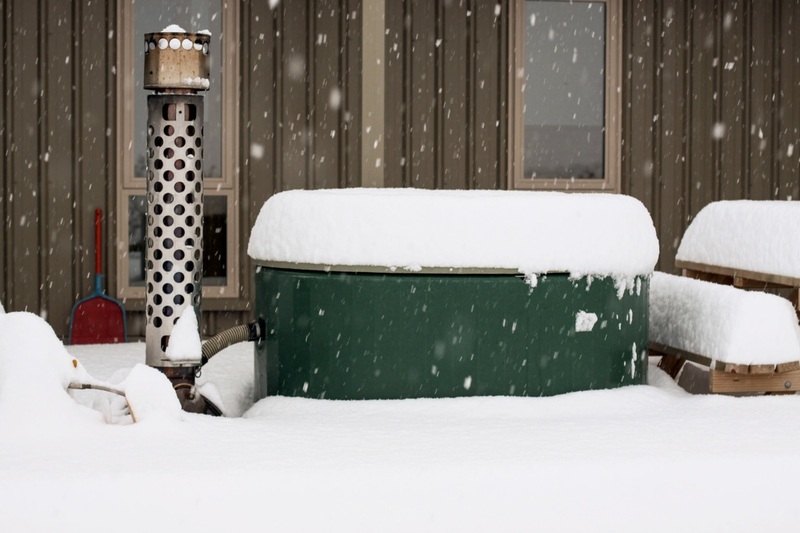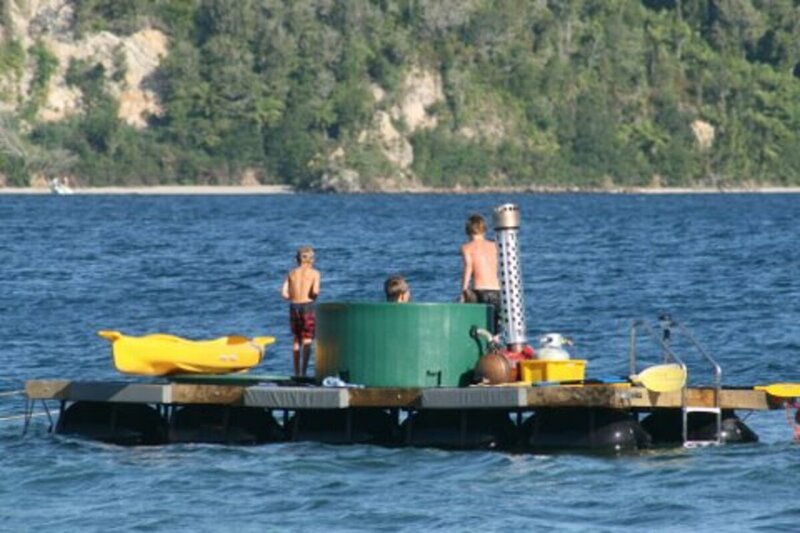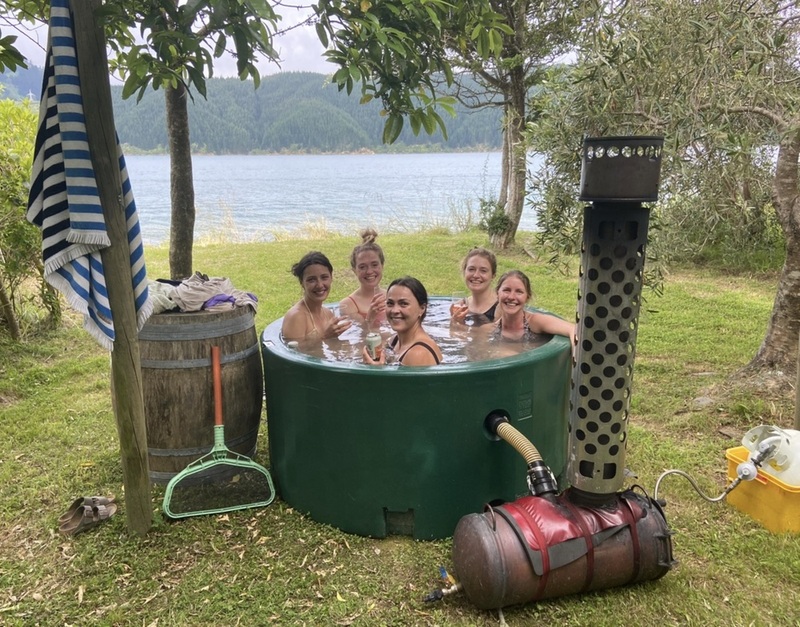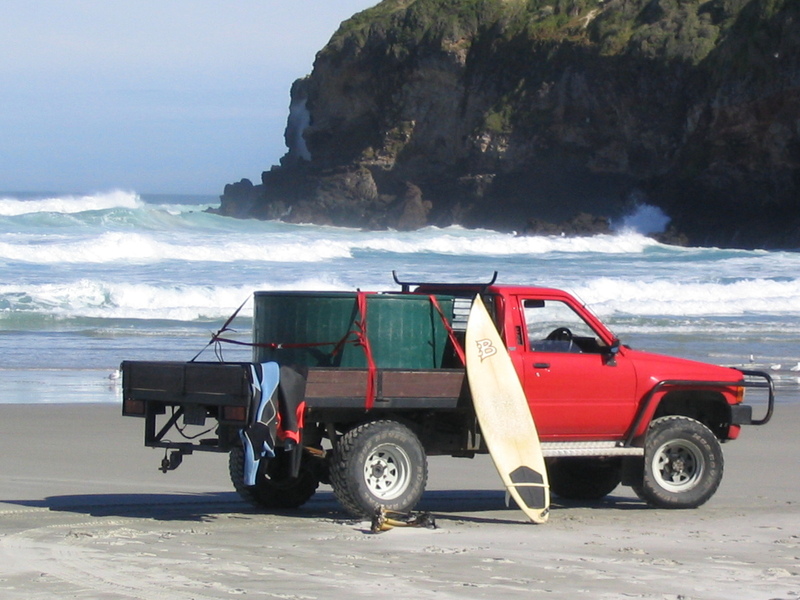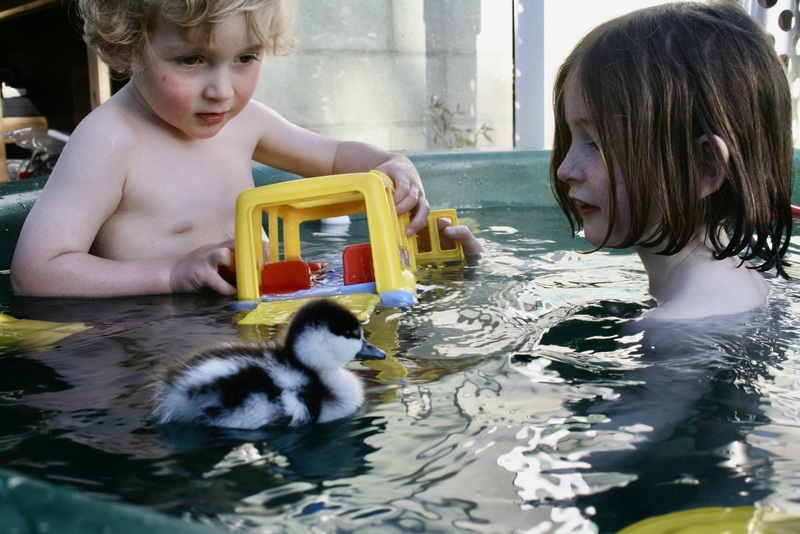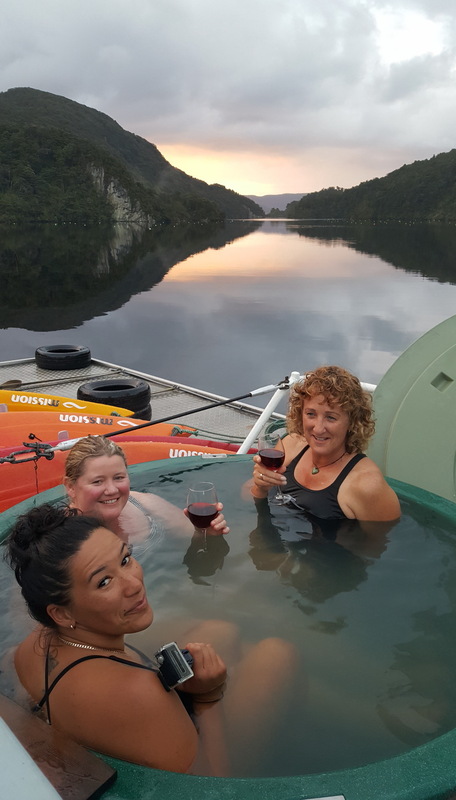How it works
- The Kiwitub is NOT a spa pool.
- The convection loop hot tub system means no pump, electricity, or chemicals.
The Kiwitub will heat up from cold water to hot steaming bath temperature really fast. Say about an hour to 90 minutes on gas; longer on firewood. This means you can leave it empty until needed, fill it with clean fresh water or seawater (no chemicals), light the burner and have the tub hot for soaking in roughly an hour or two.
You can usually keep the same water in for 2-3 days without needing to add chemicals. So it's ideal for the weekend, the bach (crib), periodic use at home, camping, glamping, boats, back country huts or for a B&B or farmstay. It's not like a spa pool where the same water stays in for months, needing chlorine or other chemicals added every day or two, and with ongoing electricity costs whether you're in it or not.
Here's how we do it.
The Kiwitub burner is essentially two horizontal cylinders, one inside the other, with water in between, connected by two hoses to the hot tub. Fire in the central burning chamber heats the water surrounding it, which expands and rises up through the top hose and into the tub. At the same time, cooler water flows in through the bottom hose to replace it.
This circulation continues as long as there is a heat source of any sort in the burning chamber, so the water in the tub gets steadily hotter. It's exactly the same as a wetback on a domestic woodburner heating the hot water cylinder in your home. You can use firewood, gas (LPG) or some other fuels in the same Kiwitub burner.
The patented system has no heavy, noisy, fragile, electricity-consuming pumps, unlike a spa pool. Once the water in the insulated tub is hot, it'll stay that way for several hours - you don't need to keep the fire or gas going. Overnight, with the lid on, it'll lose only a few degrees of heat. So just fire up the burner for 10-20 minutes the next morning to boost the water fully up to hot steaming bath temperature again before getting back in. With coffee, of course.
The Kiwitub is designed for out-of-doors, manual operation under adult supervision. It does not have an automatic temperature regulator. Just turn off the gas when the water is hot enough, or stop putting wood on the fire when it almost is. It's that simple.
The tub and copper burner are designed to be brutally strong and very long-lasting, well past the five years manufacturers' guarantee. Small components can be readily and cheaply replaced, if necessary.
The Kiwitub takes only a few minutes to set up for use. Just screw the two hoses into the tub, clip the fittings at their other ends onto the burner, and wriggle the flue into the top of the burner. You're ready to go.
You can use it at home or take it places. A lot of places..
Moving the Kiwitub around.
You can just use the Kiwitub in the backyard of your house, on the deck, down the garden, beside the swimming pool. But there are other possibilities..
We've taken the tub up to a frozen lake for ice diving, into the mountains, out to islands, beside rivers, on the beach. It'll fit on a boat or big whitewater raft, or in the net under a helicopter. It's deal for a weekend bach or tramping hut. Or just fire it up for Saturday night. Or take it round to the party. Or invent Extreme Tubbing...
The tub will fit on or in any suitably-sized ute, pick-up truck, light car or boat trailer, SUV, boat, or large inflatable raft. It'll roll through a standard doorway.
The tub comes with plastic screw-in plugs for the two hose outlet holes to keep dust and water out. It floats amazingly well and can be towed behind a boat or canoe, or paddled. Driving it with an outboard motor is defintely a learning curve - or rather a series of them.. Floats well; steers like a grand piano.
Its 1.53m (5ft) diameter x 0.75m (30in) depth is also padlockable dry storage space. The burner and flue pack inside the tub, with plenty of room left over for up to 10 tramping (hiking) packs. The empty tub weighs 69kg (150 lb) and the lid another 16kg (35 lb).
Filling and emptying the tub - no plumbing needed.
The tub fills with 800L (180 gal.) of fresh water or sea water. Just fill it with a garden hose - this takes 15-30 minutes or so, depending on your water pressure. Or, just bucket the water in. Two of us with a bucket each filled the tub in three minutes flat on a little island in Lake Whakatipu. (See the main home page photo.)
Empty the tub by opening the drainage cock on the back of the burner - the tub will drain in an hour or so. Just connect a garden hose to the drainage cock to run the water onto the lawn, vegetable garden, runoff channel from house roof gutters, stormwater drainage, etc. It's fine for plants because of the lack of chemicals, so it's not wasted water.
Or, you can just disconnect the lower hose from the burner - this takes about two seconds to do and the tub will empty in two minutes.
Heating times.
The 36kW Kiwitub burner will heat our tub up from cold to 40˚C hot steaming bath temperature really quickly. Say roughly an hour or so on gas, or two hours or so on firewood. By comparison, a big electric heater in your home would be about 3kW, and a spa pool heater only 1-2kW. Spa pools can take 10-20 hours to heat up from cold, so to have them reasonably accessible they get left on continuously. This costs in elecricity, and it's not "a dollar a day." Just ask someone who's got one.
The Kiwitub just stays empty (with no ongoing costs) until needed, then you can fill and heat it fast - say when someone drops round with a bottle of wine. This happens quite a lot.
The heating times do vary. The season, weather and altitude will all make a difference. How cold the water is to start with counts for a lot. In summer in Dunedin it's about 15˚C, so takes us an hour to heat up the tub on gas (LPG). In midwinter it's only 4˚C, so takes 90 minutes to climb to the same steaming 40˚C bath temperature. It took us two hours starting with 0˚C up at Lake Alta near the top of the Remarkables, mostly buried in snow. We think that's a maximum. The record is only 45 minutes on Waiheke Island in summer.
Gas varies surprisingly. I had thought all LPG is the same, but it's not. It's a mix of propane (the good stuff) and butane (not so good), and the ratio varies. When I looked into this and ran time trials using 9kg bottles a few years ago, the best was Rockgas from Contact Energy with 90% or more propane; Gemini gas was almost as good; and the Ongas and Elgas swappa bottles were quite poor - only 60% propane if that. As well, if a swappa bottle has been returned with gas still in it, that'll be mostly butane (because the propane has burned off first). This can build up over subsequent fills so that a poor bottle can take 30-40% longer to heat the tub than a good one.
Very roughly, you'll get about three heat-ups from cold of the tub out of a single 9kg LPG barbecue-type gas bottle - in summer, or north of Auckland. In the Southern winter, or up a mountain, you'll probably get only two.
In Australia, the gas in the 9kg bottles is 100% propane - which is better than we get in New Zealand. Also they have all that lovely dry eucalypt to make a cracking fire. So the tub does heat faster over there.
CURRENTLY UNAVAILABLE: The gas tube burner is currently unavailable, as at April 2024. The gas burner apparently needs to be re-tested and re-certified, although we've also had expert opinions that our original testing and approval still holds. We're trying to do it right, but it's slow and tortuous. So we can't sell the gas unit until it's sorted - hopefully by mid-2024. Not including it drops the price of the standard full Kiwitub package to $7,300, and the price of the standard main burner package to $3,500. If you send us your contact details we can let you know when they are available again.
Firewood varies even more. Not everyone knows how to light a decent fire any more. It's a good skill to learn, and there will always be older people ready to teach. I know of several baches where the kids were told if they wanted a hot tub, it was up to them to heat it up. Laying and lighting and running a fire in the burner has now become a highlight of going to the bach for them. There are instructions and useful tricks in the manual, e.g. starting the fire with a hot air gun. Lots of fun!
The fastest time we know of is only an hour to heat the tub in winter with ice on the ground - using oak. (The grandfather had planted an oak plantation and the burner is run on windfall branches dried for a year or more.) Okay - not typical, but it does show what's possible.
The two stainless steel tubes under the fire grate act like a big secondary air intake, sucking in fresh fully-oxygenated outside air and spilling it underneath the fire. They turbocharge the performance on firewood, and we can get the entire flue red hot. This is 1,040˚C for stainless steel, which is why there's the perforated aluminium safety shield around the flue.
So you do need good dry thinnish lathes of wood. Light dry fast-burning wood like willow and poplar is fine, or the hotter fierce burning woods like manuka, eucalypt, macrocarpa, etc. Dry, open pine cones are great, as are vineyard or orchard prunings and trimmings. We've just used driftwood when camping many times. Pine is the one wood we've had problems with - unless it's seriously dry it can leave creosote sap coating the inside of the burner.
Very roughly, call it 2-3 hours usually to heat the tub up over summer and winter, on firewood. It's about enough time to welcome friends, feed them a meal while periodically putting wood on the fire, and get the tub hot enough for bathing by the time of the coffee and liqueurs. It's longer than on gas, because to have a fierce fire you need a good air flow, which means that more of the heat goes up the flue than happens with gas. There's a damper at the base of the flue and an adjustable air intake in the door to control the air flow.
Firewood is carbon neutral, releasing about the same emissions to the atmosphere as it would just rotting in a forest. If you can gather it, then it's free. LPG is the most benign greenhouse gas, and the Kiwitub doesn't use much anyway. However, even if you're not using it now, the firewood option is always there with the burner - which we expect to last a very long way into an interesting future.

